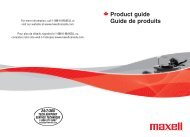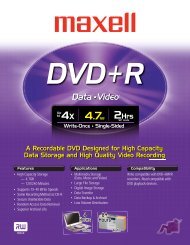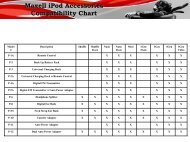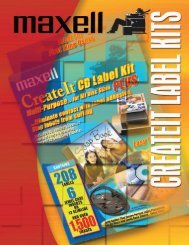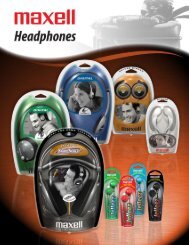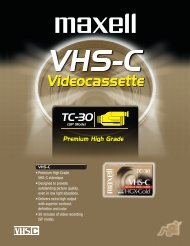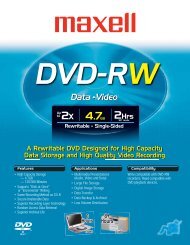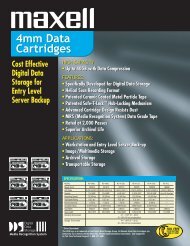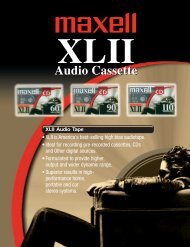DVD Compatibility Test - Maxell Canada
DVD Compatibility Test - Maxell Canada
DVD Compatibility Test - Maxell Canada
- No tags were found...
You also want an ePaper? Increase the reach of your titles
YUMPU automatically turns print PDFs into web optimized ePapers that Google loves.
VIDEO • AUDIO • 3D • WEB VIDEO • <strong>DVD</strong> • VISUAL EFFECTSJULY 2002®www.dv.comROUNDUP<strong>DVD</strong> COMPATIBILITYTESTHow can you author a <strong>DVD</strong> that everyone canread? <strong>Compatibility</strong> is a complex issue, but wesort it out with some hard data. By Ralph LaBargeFor many years, I have been a devoted fanof recordable <strong>DVD</strong> technology, and I’vebuilt my business around it as a <strong>DVD</strong>developer. It’s crucial that I understand how Ican author discs that can be read by thewidest number of viewers so I can avoidreturns, excess technical support, and generalend-user frustration. But there are many variablesin the <strong>DVD</strong> world.In my studio, I have first-, second-, andthird-generation <strong>DVD</strong>-R burners from Pioneer;first- and second-generation <strong>DVD</strong>-RAMdrives from Panasonic; and first-generation<strong>DVD</strong>+RW drives from HP and Sony. When<strong>DVD</strong>+R drives become available later thisyear, I’ll be the first one on my block to buyone.I use recordable <strong>DVD</strong> extensively in developingand testing titles before I send them outfor replication. Other <strong>DVD</strong> producers circumventreplication and release recordable <strong>DVD</strong>sthey’ve burned themselves.ILLUSTRATION BY RALPH KELLIHER
ROUNDUPWith the release of set-top <strong>DVD</strong> recordersfrom Panasonic, Pioneer, and others, recordable<strong>DVD</strong> is rapidly becoming a mass-marketproduct. Computer-based <strong>DVD</strong> burners arereadily available for less than $400, and settopunits can be bought for less than $1000.Combined with inexpensive <strong>DVD</strong> authoringtools from companies such as Apple, PinnacleSystems, Sonic Solutions, Ulead, and others,affordable systems for making your own <strong>DVD</strong>discs are becoming a reality for many consumers.But compatibility issues are growingexponentially.Unfortunately, there is trouble in recordable<strong>DVD</strong> paradise. As with most new technologies,recordable <strong>DVD</strong> has a compatibilityproblem. This compatibility problem hasthree main factors—the <strong>DVD</strong> formats (e.g.,<strong>DVD</strong>-R, <strong>DVD</strong>+RW, <strong>DVD</strong>-RW), the <strong>DVD</strong> blankmedia manufacturers (e.g., <strong>Maxell</strong> andVerbatim), and the <strong>DVD</strong> players (e.g., Pioneerand Sony)—that have complex permutations.This article is anattempt to bring sanityto how compatibility isreported for recordable <strong>DVD</strong>media on consumer<strong>DVD</strong>-Video players.The purpose of this article is to make <strong>DVD</strong>producers, vendors, and consumers aware ofthe compatibility issues for recordable <strong>DVD</strong>.The compatibility of replicated <strong>DVD</strong>s, burnedfrom glass masters in high volumes at large<strong>DVD</strong> replication houses, is outside the scopeof this story. I will explore the issues thataffect <strong>DVD</strong> producers who burn smaller runsthemselves.I’ll provide recommendations on how toavoid problems when you record <strong>DVD</strong> discsand how to attain the widest compatibility soyour <strong>DVD</strong> can be watched by as many peopleas possible. Then I’ll wrap up with a few generalguidelines to help you get the most outof recordable <strong>DVD</strong>.A brief overview ofrecordable <strong>DVD</strong> technologyLet’s start by taking a look at the differenttechnologies used to make a recordable <strong>DVD</strong>.There are currently five different types ofrecordable <strong>DVD</strong> products on the market.These products are <strong>DVD</strong>-R for Authoring,<strong>DVD</strong>-R for General, <strong>DVD</strong>-RW, <strong>DVD</strong>+RW, and<strong>DVD</strong>-RAM. A sixth product, <strong>DVD</strong>+R, shouldbe widely available within the nextfew months. Each of these recordable <strong>DVD</strong>technologies has its own strengths and weaknesses.<strong>DVD</strong>-R for Authoring, <strong>DVD</strong>-R for General,and <strong>DVD</strong>+R all use organic dyes that are sensitiveto an infrared laser. <strong>DVD</strong>-R for General and<strong>DVD</strong>+R discs are recorded using a 650nm(nanometer) laser, while <strong>DVD</strong>-R for Authoringdiscs are recorded using a 635nm laser. Whenthe organic dye is exposed to a low-powerinfrared laser, it is permanently changed andthe data is recorded onto the disc. Therewritable formats—<strong>DVD</strong>-RW, <strong>DVD</strong>+RW, and<strong>DVD</strong>-RAM—use phase-change materials. Thereare two different power levels used for writingand erasing data on a phase-change disc. Thehighest power level causes the surface of thematerial to become less reflective, and a lowerpower level causes the material to becomemore reflective. Phase-change-based recordable<strong>DVD</strong> media can be rewritten more than 1000times, but the organic dye material used in<strong>DVD</strong>-R and <strong>DVD</strong>+R media can only be writtenonce.Potential compatibility problemsSeveral different compatibility problems canoccur between a recorded <strong>DVD</strong> disc and aconsumer <strong>DVD</strong> player. These problemsinclude physical, logical, and applicationincompatibilities. The <strong>DVD</strong> specificationstates that single-layer discs should have areflectivity between 45 percent and 85 percent,and dual-layer discs should have areflectivity between 18 percent and 30 percent.The first potential problem with recordable<strong>DVD</strong> media is if their reflectivity fallsoutside the specified ranges.The <strong>DVD</strong> specification also defines severallogical parameters that are important forrecordable <strong>DVD</strong> media. These parameters arestored in the header area of each data sectoron the disc, and they include sector type format,tracking method, reflectivity, layers, anddata type information. Each logical parametermust be set correctly for a recordable <strong>DVD</strong>disc to work properly.Application-level compatibility problemsare generally related to the average and burstdata rates of the content stored on the disc.In theory, any recorded <strong>DVD</strong> disc that complieswith the <strong>DVD</strong> specification should workfine on all consumer <strong>DVD</strong>-Video players.However, in practice, recorded <strong>DVD</strong> discswith high average or burst data rates, or withdata stored at or near the outer edge of thedisc, are more likely to exhibit playback compatibilityproblems.Several differentcompatibility problems canoccur betweena recorded <strong>DVD</strong> discand a consumer<strong>DVD</strong> player. Theseinclude physical,logical, and applicationincompatibilities.Physical, logical, and application compatibilityproblems can manifest themselves in anumber of different ways. Many consumer<strong>DVD</strong>-Video players will fail to mount arecorded <strong>DVD</strong> disc. When this happens, theplayer usually displays an error message indicatingthat the disc is damaged, has thewrong region code, or, in some cases, a diagnosticcode. Other typical problems includevideo artifacts, audio dropouts, and navigationproblems that prevent portions of thedisc from being accessed. In some cases, a<strong>DVD</strong>-Video player may lock up while playing arecorded <strong>DVD</strong> disc.What is compatible?One of the most frustrating things that canhappen to a <strong>DVD</strong> developer is to send recordeddiscs to clients, friends, or relatives, and thediscs fail to play properly on their systems.Many developers know enough about potentialcompatibility problems that they tell theirclients or friends to use a compatible player inorder to use the disc they send them, but whatcompatible means isn’t always clear.A number of Web sites—such aswww.vcdhelp.com/dvdplayers.php, www.apple.com/dvd/compatibility, and www.<strong>DVD</strong>Made-Easy.com—provide information about compatibleplayers. Unfortunately, the data
ROUNDUPfound on some of these <strong>DVD</strong> compatibilityWeb sites is based on anecdotal informationand relies on individual end users to reporttheir experiences with how a single brand ofrecordable <strong>DVD</strong> media works on a specificmake and model <strong>DVD</strong> player. Because thereare no common standards to define whatcompatibility is, the information found onthese sites must be taken with a grain of salt.I have a rather simple definitionof compatibility as it relates to recordable<strong>DVD</strong>: A recordable <strong>DVD</strong> disc is compatiblewith a consumer <strong>DVD</strong>-Video player if itworks identically to a replicated disc createdfrom the same disc image. In other words,end users should expect that recorded <strong>DVD</strong>discs will work as well as replicated discs purchasedfrom a retail store.The ultimate recordable <strong>DVD</strong>compatibility testFor many years, I have been telling anyonewho would listen that we need a more rigorousmethod of determining the compatibilityof recordable <strong>DVD</strong> discs on consumer <strong>DVD</strong>-Video players. I know many of the <strong>DVD</strong>-Video player manufacturers and recordablemedia vendors have internal compatibilitytesting programs. However, the results ofthese internal testing programs are rarely disclosedto the general public, or even the <strong>DVD</strong>development community. After discussingthis problem with the DV editors, we decidedto undertake a rigorous compatibility testingeffort and publicize the results. This article isan attempt to bring sanity to how compatibilityis reported for recordable <strong>DVD</strong> mediaon consumer <strong>DVD</strong>-Video players.A recordable <strong>DVD</strong> discis compatible with aconsumer <strong>DVD</strong>-Video playerif it worksidentically to a replicateddisc created from the samedisc image.I have an engineering background. Morethan 20 years ago, I graduated with a bachelor’sdegree in electrical engineering and went towork for a Department of Defense contractordesigning digital signal processing equipment.An integral part of designing electronic equipmentis to develop a test plan and procedure tomake sure that every unit that comes off theproduction line works as well as, or better than,the first prototype unit.Developing a test plan to determine thecompatibility of recordable <strong>DVD</strong> media is actuallyquite simple. You need to test every possiblecombination of <strong>DVD</strong> format, blank mediabrand, player brand, player model, and playerrevision. Then you must repeat those tests withmultiple copies of each <strong>DVD</strong> format and brandon multiple copies of each player make andmodel to eliminate any random variables thatmight have influenced the test results (like ascratch on one of the test discs or a bad integratedcircuit in a player).I discovered there were more than 50 differentcombinations of recordable <strong>DVD</strong> formatsand media brands, and over 400 differentmakes, models, and revisions of <strong>DVD</strong>-Video players. This adds up to over 20,000different tests that would have to be run foronly a single instance of media on one copyof every player! If the test were expanded toinclude multiple media copies tested on multipleplayers, the total number of tests wouldquickly exceed 100,000.A realistic recordable <strong>DVD</strong>compatibility testThen reality set in, and I realized I had toapproach the problem in a more feasible manner.I wrote a test plan and procedure that Icould actually implement given time, budget,and labor constraints, yet was still a good,thorough (not to mention unprecedented) testto determine compatibility. I set a $1000 budgetto cover the cost of acquiring blank recordable<strong>DVD</strong> media and shipping all of it to varioustest facilities. The biggest problem waslabor, which was solved through the generouscontribution of staff time by five differentcompatibility testing companies in the <strong>DVD</strong>industry, none of whom make or sell recordable<strong>DVD</strong> media or <strong>DVD</strong> players.The test’s source material came from two<strong>DVD</strong>-Video disc images I authored using SonicScenarist NT 2.5. One disc image was used forfull-capacity (4,700,000,000-bytes) media, anda second disc image was used for limitedcapacity(3,950,000,000-bytes) media. Thefull-capacity disc image is the Naxos Musical<strong>Test</strong>ing FacilitiesFive different companies participated inour testing: Still in Motion, <strong>Test</strong>ronicLaboratories, Alpha <strong>DVD</strong>, and two companiesthat requested to remain anonymous.Still In MotionStill In Motion, a Technicolor Company, isa leading <strong>DVD</strong> authoring service bureauserving the Hollywood studio market andspecializing in Class A titles. Recent projectsinclude domestic and internationalreleases of Snow White and the SevenDwarfs, Platinum Edition; Atlantis: The LostEmpire; Unbreakable; and the award-winning<strong>DVD</strong> Cosmos, the late Dr. CarlSagan’s PBS science series. Still In Motionprides itself on its ability to consistentlyoffer the most advanced and innovativefeatures in the <strong>DVD</strong> industry.www.stillinmotion.com<strong>Test</strong>ronic Laboratories<strong>Test</strong>ronic Laboratories offers professional,confidential product verification services,tailored to meet the needs of the homeentertainment industry, from facilities inPinewood Studios, London, and Burbank,CA. Both sites operate to identical standards,guaranteeing the uniformity ofapproach essential to multinational contentowners and distributors. Establishedin 1998, <strong>Test</strong>ronic Laboratories is staffedby QA professionals with over 70 years ofcombined experience in related industries.www.testroniclaboratories.com ■Journey Saint-Saens & Bizet. The limited-capacitydisc image is The Call. Both titles were releasedduring 2001 by <strong>DVD</strong> International and replicatedby Panasonic Disc Services Corporation.I arranged for the discs to be tested infive internal compatibility labs, includingtwo major <strong>DVD</strong> replication houses becausethey have the widest range of <strong>DVD</strong> playersand independent positions in the industry.See the “<strong>Test</strong>ing Facilities” sidebar (above)for more information about some of the testsites. They followed detailed test proceduresI wrote for each of the two disc images totest content from every area of the disc. Thefull-capacity (4.7GB) disc test procedureincluded 28 unique steps, and the limited-
ROUNDUPFigure 1—Brands of Recordable <strong>DVD</strong> Media <strong>Test</strong>ed, by <strong>DVD</strong> Format<strong>DVD</strong>-R forAuthoring(3.95GB)MitsuiPioneerRidataTDKVerbatim<strong>DVD</strong>-R forAuthoring(4.7GB)<strong>Maxell</strong>MitsuiPioneerRidataRitekTaiyo YudenTDKVerbatimHere are the formats and brands of recordable <strong>DVD</strong> we tested. Five copies of the source disc image wereburned for each media type and brand, then sent to independent testing facilities for compatibility testing.capacity (3.95GB) disc image had 16 uniquesteps.With compatibilityratings of less than50 percent for certainbrands of media,recordable <strong>DVD</strong> upsetssome developers.The test <strong>DVD</strong> titles were chosen as sourcematerial because both titles had high-bitratecontent, utilized over 97 percent of the disc’scapacity, and had been released as a replicatedtitle. Using high-bitrate content and discs thatwere close to full capacity meant it would beeasy to spot errors caused by a recordable <strong>DVD</strong>compatibility issue. If a <strong>DVD</strong> player has toreread data on the disc, the video is visiblypaused as it rereads, and an audio dropout mayoccur. Replicated copies of each disc imagewere also tested on every player to ensure thatany detected problems were a result of theirstorage on recordable <strong>DVD</strong> media rather than aflaw in the encoding, authoring, or layout ofthe test disc image.In order to pass the test, a recorded dischad to display the video, audio, and graphicsat the same level of quality as the replicatedversion of the title. Each test facility lookedfor skipped frames, pauses, stuttering, or digitalartifacts in the video as they listened fornoise, pops, or dropouts. The test facilitiesalso tested menu navigation. The recordeddisc had to navigate correctly through thetitle’s menu system to pass the test.<strong>DVD</strong>-R forGeneral(4.7GB)AppleCD-Recordable.comImation<strong>Maxell</strong>MemorexMitsuiPanasonicPioneerRidataRitekSonyTDKVerbatimVivastar<strong>DVD</strong>-RW(4.7GB)JVCMemorexPioneerRidataRitekSonyTDKVerbatim<strong>DVD</strong>+RW(4.7GB)HPMemorexSonyVerbatimMedia types and brandsFigure 1 (above) shows a list of the recordable<strong>DVD</strong> formats and brands that were includedin this test. I would like to thank many of thelisted vendors who provided samples of eachmedia type. In addition to media samplesprovided by vendors, we purchased approximately$1500’s worth of blank media.I chose not to include <strong>DVD</strong>-RAM media inthe test because an extreme minority of consumer<strong>DVD</strong> players and <strong>DVD</strong>-ROM drives arecapable of reading this format. My testingwas a bit too early to include <strong>DVD</strong>+R, but staytuned to DV and DV.com for future updateson that format.<strong>DVD</strong>-Video playersFigure 2 (below) shows a list of the makesand models of <strong>DVD</strong>-Video players we tested.Over 2400 unique tests were performed,Figure 2—<strong>DVD</strong>-Video Players <strong>Test</strong>edrequiring well over 400 hours of testing labor.Only players that were designed to handleat least one of the recordable <strong>DVD</strong> formats listedin Figure 1 were included in the test matrix.Every effort was made to include current modelsfrom each vendor, although we were constrainedby the specific player makes and modelsavailable at each test facility. The acquisitiondate of each player is listed in parenthesesnext to the model number.Making the test discsThe first step in making the test discs was torecord five copies of each unique <strong>DVD</strong> formatand manufacturer brand. In order to eliminateas many variables as possible, I recordedat conservative speeds. <strong>DVD</strong>-R and <strong>DVD</strong>-RWdiscs were recorded at 1x speed, and<strong>DVD</strong>+RW media were recorded at 2.4xspeed—the lowest speed settings for eachdrive type.<strong>DVD</strong>-R for General media were recordedon a Pioneer DVR-A03 using B’s RecorderGold software. <strong>DVD</strong>-R for Authoring mediawere recorded on a Pioneer DVR-S201 usingPrassi <strong>DVD</strong> Rep 2.0 software. <strong>DVD</strong>+RW mediawere recorded on a Sony DRU110A driveusing B’s Recorder Gold software.After each disc was burned, I tested it onboth a Pioneer <strong>DVD</strong>V7400 and Sony DVPS400player to verify that the recording was completedsuccessfully. If the test disc passed alltests on each player, the disc was numberedand set aside for shipping to one of the five testfacilities. If the test disc failed any test, it wasdestroyed so it couldn’t be used.Akai DVP1000 (1998)Apex AD500W (2001), AD600A (2001), AD660 (2000)Denon <strong>DVD</strong>1000 (1998)GE GE1105P (2000)Hitachi DVP305U (2000), DVP315U (2000)JVC XV511BK (1999), XV523GD (2000), XVD723GD (2001)Kenwood <strong>DVD</strong>404 (2001)KLH <strong>DVD</strong>221 (2000)Magnavox <strong>DVD</strong>611 (2001)Microsoft XBox (2001)Oritron <strong>DVD</strong>100 (1999), <strong>DVD</strong>200 (2000)Panasonic <strong>DVD</strong>A100 (1998), <strong>DVD</strong>A300 (1999), <strong>DVD</strong>A350 (1998), <strong>DVD</strong>RP56 (2001), <strong>DVD</strong>RV20 (2001), <strong>DVD</strong>RV31 (2001)Philips <strong>DVD</strong>621 (2002), <strong>DVD</strong>711 (2000)Pioneer DV333 (1999), DV341 (2001), DV414 (1998), DV434 (2000), DV500 (1997), DV505 (1998), DVC302D (1999),DVS9 (1998), <strong>DVD</strong>V7400 (2000), PDVLC10 (2000)Proscan PS8680Z (1999)RCA RC5200P (1997), RC5215P (2000), RC5220P (2000), RC5400P (2002)Samsung <strong>DVD</strong>M301 (2001), <strong>DVD</strong>511 (2000), <strong>DVD</strong>611 (2000), <strong>DVD</strong>709 (2000)SMC <strong>DVD</strong>3308 (1999)Sony DVPNC600 (2001), DVPS315 (1998), DVPS330 (1999), DVPS345 (2000), DVPS360 (2001), DVPNS400 (2002),DVPS550 (1999), DVPNS700P (2001), DVPS7000 (1997), DVPS7700 (1999), Playstation 2 (2001)Thomson DTH1000 (1998)Toshiba SD1700 (2001), SD2300 (2000), SD2700 (2001), SD3000 (1996), SD3006 (1997), SD4700 (2002), SD6109C (2000),SD6200 (2000)Zenith <strong>DVD</strong>2100 (1999), <strong>DVD</strong>2200 (1999)Here are the makes and models of <strong>DVD</strong>-Video players we tested with acquisition dates in parentheses.Over 2400 unique tests were performed, requiring well over 400 hours of labor.
ROUNDUPFigure 3—A Section of the <strong>Test</strong> Results Matrix4.7GB <strong>DVD</strong>-R (G)12345678910111213143.95GB <strong>DVD</strong>-R (A)123454.7GB <strong>DVD</strong>-R (A)123456784.7GB <strong>DVD</strong>-RW123456784.7GB <strong>DVD</strong>+RW1234Replicated DiscsSaint-SaensThe CallPlayer 1✔+O✔-✔+✔+✔-✔-✔-✔-✔+✔+✔+✔+✔+✔+✔+✔+✔+✔+✔-✔+✔-✔-✔-✔-✔+✔-✔+✔+✔+✔+✔+✔+✔+✔+✔+✔+✔+✔+✔+✔+Player 2✔+O✔-✔-✔+✔-✔-✔+✔-✔+✔+✔+✔+✔-✔+✔+✔+✔+✔+✔-✔+✔-✔+✔+✔+✔+✔-O✔+✔-✔+✔-✔+✔+✔+OOOO✔+✔+Player 3✔+✔+✔+✔+✔+✔+✔+✔+✔-✔-✔+✔+✔+O✔+✔+✔+✔+✔+✔-✔+✔+✔+✔+✔+✔+✔+✔+✔+✔+✔+✔+✔+✔+✔+✔+✔+✔+✔+✔+✔+Player 4✔-✔-✔-✔+✔+✔-✔-✔-✔-✔-✔+✔+✔-✔+✔+✔+✔+✔+✔+✔+✔+✔-✔-✔-✔-✔-✔-✔+✔+✔+✔+✔+✔+✔+✔+✔+✔+✔+✔+✔+✔+Player 5✔+✔+✔+✔+✔+✔+✔+✔+✔+✔+✔+✔+✔+✔+✔+✔+✔+✔+✔+✔+✔+✔+✔+✔+✔+✔+✔+✔+✔+✔+✔+✔+✔+✔+✔+✔+✔+✔+✔+✔+✔+Player 6✔+✔-✔+✔-✔-✔-✔+✔+✔+✔-✔+✔+✔+✔-✔+✔+✔+✔+✔+✔+✔+✔+✔+✔+✔+✔-✔+✔-✔+✔+✔+✔+✔+✔+✔+✔+✔+✔+✔+✔+✔+Player 7✔+✔+✔+✔+✔+✔-✔+✔+✔+✔+✔-✔-✔+✔+✔+✔+✔+✔+✔+✔+✔+✔+✔+✔+✔+✔+✔+OOOOOOOOOOOO✔+✔+one player, work marginally on a secondplayer, and fail to work at all on a thirdplayer. It was also common for a singleplayer to play some but not all brands of thesame type of media.Draw the right conclusionsIf I had the time, money, and staff to do amore complete test that included multiplecopies of each media format and brand, aswell as multiple units of each player make andmodel, I would consider publicizing the rawdata—but as the raw data stands, it’s prone tomisinterpretation. The samples in this test arelarge enough to draw general conclusionsabout recordable <strong>DVD</strong> compatibility, but notlarge enough to draw specific conclusionsabout the performance of a specific playermodel or vendor manufacturer.The potential for misinterpretation, as wellas the sheer size required, is why we’re notprinting the raw data in this article. I’m alsonot going to give out test results for a specificbrand of media or make and model player.However, with over 2400 test results, I candraw accurate conclusions about the compatibilityof different types of recordable <strong>DVD</strong>formats and media brands.LegendPasses All <strong>Test</strong>sFails Some <strong>Test</strong>sFails All <strong>Test</strong>s✔+✔-OA small sample of the test results matrix, which shows the inconsistencies of recordable <strong>DVD</strong>. We don’tlist the names of the <strong>DVD</strong> players because the purpose of this test is to draw general conclusions aboutrecordable <strong>DVD</strong> compatibility, not specific conclusions about the performance of a particular player.I burned a total of 209 discs for the test.One hundred ninety-five were used to createfive sets of 39 test discs. I had 14 discs thateither failed during the burning process ordidn’t work properly in the initial test. I senta set of 39 test discs and one copy of eachreplicated disc to each of the five test facilities,along with the detailed test procedures.Running all 41 discs through a single playertook approximately five hours.The test resultsThree possible results were recorded for eachtest: Passes All <strong>Test</strong>s, Fails Some <strong>Test</strong>s, andFails All <strong>Test</strong>s. <strong>Test</strong> data sheets were completedby each facility for every combinationof <strong>DVD</strong> format, media brand, and playermake and model. All test results were forwardedto me, and then I compiled theminto an extensive test results matrix. Figure3 (above) shows a very small sample ofthe matrix.When the results were displayed in thisfashion, the results clearly show the inconsistenciesof recordable <strong>DVD</strong>. It was commonto have one disc work flawlessly onFigure 4—<strong>Compatibility</strong> by Media Type (Passes All <strong>Test</strong>s)1008060402009667 6658<strong>Compatibility</strong> Percentage (%)56Conclusion #1:<strong>DVD</strong> format mattersThe first conclusion that can be drawn fromthe test results is that the format of recordable<strong>DVD</strong> media is important in determiningcompatibility between a recorded disc and a<strong>DVD</strong> player. The data in Figure 4 (below)includes only the test cases that had a “PassesAll <strong>Test</strong>s” result, indicating that the test discwas compatible with the test player.As you can see from Figure 4, the 3.95GB<strong>DVD</strong>-R for Authoring format is the most compatible,followed by 4.7GB <strong>DVD</strong>-R forAuthoring and 4.7GB <strong>DVD</strong>-R for General,3.95GB <strong>DVD</strong>-R for Authoring4.7GB <strong>DVD</strong>-R for Authoring4.7GB <strong>DVD</strong>-R for General4.7GB <strong>DVD</strong>-RW4.7GB <strong>DVD</strong>+RWLooking only at the test cases that had a “Passes All <strong>Test</strong>s” result, the 3.95GB <strong>DVD</strong>-R for Authoring formatis the most compatible, and <strong>DVD</strong>-RW and <strong>DVD</strong>+RW are the least compatible of the <strong>DVD</strong> format types.
ROUNDUPFigure 5—<strong>Compatibility</strong> by Media Type (Passes All <strong>Test</strong>s and Fails Some <strong>Test</strong>s)10080604020010086<strong>Compatibility</strong> Percentage (%)If we loosen the definition of compatible and look at test cases that had a “Passes All <strong>Test</strong>s” and “FailsSome <strong>Test</strong>s” results, 3.95GB <strong>DVD</strong>-R for Authoring is still the most compatible, and <strong>DVD</strong>-RW and <strong>DVD</strong>+RWare still the least compatible.whose test results are essentially the samegiven the margin of error in our test sample.<strong>DVD</strong>-RW and <strong>DVD</strong>+RW are the least compatibleof the media types.It is possible to use a less-strict definitionof compatibility, which includes results fordiscs that failed some, but not all, tests. Figure5 (above) shows the results if we include alltest cases that had a “Passes All <strong>Test</strong>s” and“Fails Some <strong>Test</strong>s” result in the compatibilitypercentage. This is equivalent to saying that arecordable <strong>DVD</strong> disc is compatible if the playermounts the disc and starts to play it back.The quality of playback is ignored in this definitionof compatibility.As you can see from Figure 5—even usinga less-strict definition—the 3.95GB <strong>DVD</strong>-Rfor Authoring format is the most compatible,followed by 4.7GB <strong>DVD</strong>-R for Authoring and4.7 GB <strong>DVD</strong>-R for General. <strong>DVD</strong>-RW and<strong>DVD</strong>+RW are still the least compatible of themedia types.Conclusion #2:Media brand mattersThe brand of media is also important indetermining compatibility. Figure 6 (right)shows the lowest, average, and highest compatibilityrating for each media type bybrand. As you can see, there are wide variationsin compatibility within a specific formatof media based on the media vendor.Perhaps the best example of this is in the<strong>DVD</strong>-R for General category, where theworst brand of media had a compatibilityrating of only 45 percent while the bestbrand had a compatibility rating of 86 percent.Because <strong>DVD</strong>-R for General media is byfar the most popular form of recordable<strong>DVD</strong>, the data illustrates a very importantpoint for most <strong>DVD</strong> developers: mediabrand matters! Another interesting point is8762503.95GB <strong>DVD</strong>-R for Authoring4.7GB <strong>DVD</strong>-R for Authoring4.7GB <strong>DVD</strong>-R for General4.7GB <strong>DVD</strong>-RW4.7GB <strong>DVD</strong>+RWthat <strong>DVD</strong>-RW and <strong>DVD</strong>+RW media havemuch better consistency across brands than<strong>DVD</strong>-R. In general, if a <strong>DVD</strong> player couldplay one brand of <strong>DVD</strong>-RW or <strong>DVD</strong>+RWmedia, it could play all of the brands of thesame media format.Conclusion #3:Player make and model mattersThe test results clearly reveal that the makeand model of a <strong>DVD</strong> player is just as importantas the format and brand of recordablemedia. As you can see from Figure 3, someplayers support one type of recordable media,but not another. In addition, many playersexhibit inconsistencies within a media formatby playing some brands of media flawlessly,having marginal playback on other brands,and failing to mount other brands at all.The test results demonstrate the danger ofusing anecdotal evidence or end-user testimonialsto determine recordable <strong>DVD</strong> compatibility.It is quite likely that end users will havea positive experience with one format andbrand of media on their players, but anotherend-user will have a negative experience usinga different format or brand of media on thesame make and model player.Figure 6—<strong>Compatibility</strong> Ranges According to Media Brand10080604020090604554549667 666056100Low % Average % High %7686Only 10 percent of the players we testedplayed all 39 different format and brands ofrecordable media correctly. None of the playerswe tested failed to read all 39 test discscorrectly. This means that 90 percent of theplayers tested had inconsistent results, playingsome formats or brands of media well butplaying back marginally on other formatsand brands of media.Conclusion #4:<strong>DVD</strong>-RW and <strong>DVD</strong>+RWare very similarIf you look at the data in Figures 5, 6, and 7,you can see that the overall compatibility of<strong>DVD</strong>-RW and <strong>DVD</strong>+RW is very similar, andprobably within the margin of error of thetest. The compatibility ratings of <strong>DVD</strong>-RWand <strong>DVD</strong>+RW are lower than <strong>DVD</strong>-R becausemany older <strong>DVD</strong> players won’t readrewritable formats at all. Some older playersdetect that a <strong>DVD</strong>-RW or <strong>DVD</strong>+RW disc hasthe reflectivity of a dual-layer disc (between18 and 30 percent), but they won’t play thedisc when parameters stored in the sectorheader indicate that it is a single-layer disc orhas a data type that is not supported by theplayer. These logical compatibility problemsare the primary reasons why <strong>DVD</strong>-RW and<strong>DVD</strong>+RW have lower compatibility ratingsthan <strong>DVD</strong>-R.Conclusion #5:Things are getting betterWith compatibility ratings of less than 50percent for certain brands of media, recordable<strong>DVD</strong> upsets some developers. However, acareful review of the test data offers hope. Ifwe look only at <strong>DVD</strong> players acquired during2001 and 2002, the test results improve dramatically.Figure 7 (page 7) shows the results3.95GB <strong>DVD</strong>-R for Authoring4.7GB <strong>DVD</strong>-R for Authoring4.7GB <strong>DVD</strong>-R for General4.7GB <strong>DVD</strong>-RW4.7GB <strong>DVD</strong>+RWThere are wide compatibility permutations within a specific format of media due to varying quality of blankmedia. <strong>DVD</strong>-R for General media format is by far the most popular form of recordable <strong>DVD</strong>, and has a compatibilityrange from 45 percent to 86 percent. Conversely, <strong>DVD</strong>-RW and <strong>DVD</strong>+RW media have much betterconsistency across brands than <strong>DVD</strong>-R. Media brand matters!60 56
ROUNDUPFigure 7—<strong>Compatibility</strong> by <strong>DVD</strong> Format (New <strong>DVD</strong> Players Only)10080604020010094Results for all media types are dramatically improved when we eliminate older players and only look atthe results for 2001 and 2002 models of <strong>DVD</strong> players.for the 2001 and 2002 models of <strong>DVD</strong> playersthat we tested. As you can see,the results for all media types are dramaticallyimproved when we eliminate older players.Analyzing the test results shows that theoverall level of recordable <strong>DVD</strong> compatibilityhas improved every year since <strong>DVD</strong> was initiallyreleased in 1996. A few words of caution:There are still a few models on the marketthat won’t play anything but the 3.95GB<strong>DVD</strong>-R for Authoring media, and there arealso some models that can’t play <strong>DVD</strong>-RW or<strong>DVD</strong>+RW media. If you are considering buyinga new <strong>DVD</strong> player and compatibility withrecordable <strong>DVD</strong> media is important, youshould do some homework to determine ifthe unit you want to buy can play the type ofmedia you generally use.Conclusion #6:Some media brands work betterIt is clear from the test data that some brandsof media have better compatibility than others,and that some makes and models of playerswork better than others. Figure 8 (below,left) lists the compatibility test results for allmedia brands in the tests. The players listed9389<strong>Compatibility</strong> Percentage (%)803.95GB <strong>DVD</strong>-R for Authoring4.7GB <strong>DVD</strong>-R for Authoring4.7GB <strong>DVD</strong>-R for General4.7GB <strong>DVD</strong>-RW4.7GB <strong>DVD</strong>+RWin Figure 9 (below, right) correctly played all39 recordable <strong>DVD</strong> discs in the test. Keep inmind that we only tested a subset of <strong>DVD</strong>players in the market. I am sure there aremany other players that can play all39 discs in our test perfectly, but they’re notlisted in Figure 9 because we didn’t haveaccess to those players during our test effort.A few general guidelinesLet me wrap up with a few general guidelinesto help you get the most out of recordable<strong>DVD</strong>. These suggestions are based on theresults of the testing and my experiencesworking with recordable <strong>DVD</strong> drives andmedia for the past five years.1. Use <strong>DVD</strong>-RW or <strong>DVD</strong>+RW for internaltesting. Find a <strong>DVD</strong> player that supportseither <strong>DVD</strong>-RW or <strong>DVD</strong>+RW (orboth) and use it for internal testing.Because you can rewrite these discs,you will save money over using awrite-once format such as <strong>DVD</strong>-R forAuthoring, <strong>DVD</strong>-R for General, or<strong>DVD</strong>+R.2. Use <strong>DVD</strong>-R for external testing or finalproduct delivery. Because you probablycan’t control what type of <strong>DVD</strong>player the end users have, it’s best tosend them <strong>DVD</strong>-R discs. <strong>DVD</strong>-RW and<strong>DVD</strong>+RW are still significantly lesscompatible than <strong>DVD</strong>-R, so it is betterto be safe than sorry. Also, <strong>DVD</strong>-Rmedia are much cheaper than either<strong>DVD</strong>-RW or <strong>DVD</strong>+RW.3. Use low to moderate bitrate encodingfor video if the final product will bedelivered on a recordable <strong>DVD</strong>.Although most <strong>DVD</strong> players and<strong>DVD</strong>-ROM drives can read recordable<strong>DVD</strong> discs, these discs oftenhave a higher error rate during playbackthan replicated discs do, causingthe player to reread some data sectors.Using a low to moderate (less than7Mbps) data rate for video encodingwill make the recorded disc a little easierto reread without a visible pause inthe video playback, or audio dropout.4. Use brand-name media and playerswhenever possible. Brand-name mediaare generally more expensive than offbrandmedia, but your clients, friends,and family will have fewer problems,which means you won’t be spendingtime and money on problem solving.5. If you choose to use off-brand media,record them at the lowest speed possible—1xfor <strong>DVD</strong>-R and <strong>DVD</strong>-RW, and2.4x for <strong>DVD</strong>+RW. Using slower recordingspeeds increases the overall compatibilityrating of off-brand media.6. The best value in recordable <strong>DVD</strong>media right now, in my opinion, isfrom Apple Computer. Apple sells<strong>DVD</strong>-R for General media on its ownFigure 8—Media Performance Results3.95GB<strong>DVD</strong>-R forAuthoringMitsui (98%)Pioneer (98%)Ridata (98%)TDK (96%)Verbatim (90%)4.7GB<strong>DVD</strong>-R forAuthoring<strong>Maxell</strong> (76%)Mitsui (69%)Pioneer (65%)Ridata (69%)Ritek (71%)Taiyo Yuden (63%)TDK (67%)Verbatim (59%)4.7GB<strong>DVD</strong>-R forGeneralApple (73%)CD-Recordable (45%)Imation (71%)<strong>Maxell</strong> (86%)Memorex (59%)Mitsui (73%)Panasonic (69%)Pioneer (58%)Ridata (69%)Ritek (51%)Sony (76%)TDK (76%)Verbatim (69%)Vivastar (63%)4.7GB<strong>DVD</strong>-RWJVC (59%)Memorex (55%)Pioneer (61%)Ridata (55%)Ritek (59%)Sony (61%)TDK (61%)Verbatim (61%)4.7GB<strong>DVD</strong>+RWHP (57%)Memorex (57%)Sony (57%)Verbatim (55%)<strong>Compatibility</strong> test results for all media brands in the testing effort, listed alphabetically.Figure 9—Player Performance:Perfect PlayersApex AD660Microsoft XBoxPioneer DV333Pioneer <strong>DVD</strong>V7400Pioneer PDVLC10Sony DVPS330Sony DVPS360Toshiba SD4700Only 10 percent of the players we testedplayed all 39 different types and brands ofrecordable media correctly, and here theyare. We only tested a subset of <strong>DVD</strong> players.There are probably other players that wouldplay all 39 discs in our test perfectly, butthey’re not listed because we didn’t test them.
ROUNDUPWeb site (www.apple.com) for $24.95 for afive-pack. This is by far the cheapest price Ihave seen for any of the media brands onmy recommended list.Summary and conclusionsIf you have gotten this far in the article, younow understand why the issue of recordable<strong>DVD</strong> compatibility is so important—and socomplex.Those of you who were around duringthe launch of recordable CD will rememberthat we had to solve a number of compatibilityproblems before recordable CDbecame as popular as it is today. I have nodoubt that the recordable <strong>DVD</strong> drive andmedia vendors will continue to improvetheir products and, within a few years,recordable <strong>DVD</strong> will be as popular and compatibleas recordable CD is today. Staytuned to DV magazine and DV.com forupdates on recordable <strong>DVD</strong> compatibility.Our future testing effort will be expanded toinclude more <strong>DVD</strong> formats, media brands,and players.Conclusions• <strong>DVD</strong> format, media brand, and playerinteract to determine compatibility.• <strong>DVD</strong>-RW and <strong>DVD</strong>+RW are very similar.• The most compatible format is3.95GB <strong>DVD</strong>-R for Authoring.• Name-brand media are more compatiblethan off-brand media.• Of the <strong>DVD</strong> players we tested, 90 percentshow some incompatibility.• <strong>DVD</strong> players manufactured since 2001are more compatible.Recordable <strong>DVD</strong> compatibility issues arerelated to the format, media brand, and themake and model of <strong>DVD</strong> player. It is importantto understand there are no perfectrecordable <strong>DVD</strong> formats, perfect mediabrands, or even perfect <strong>DVD</strong> players availabletoday.But if you follow the guidelines in thisstory, you will be able to minimize the effectsof recordable <strong>DVD</strong> compatibility issues onyour <strong>DVD</strong> projects. ■Ralph LaBarge has a background in electricalengineering and the design of digital signalprocessing equipment for a Department ofDefense contractor. He is also an award-winning<strong>DVD</strong> title developer, and author of thebook <strong>DVD</strong> Authoring & Production (CMPBooks, 2001). LaBarge has completed over200 <strong>DVD</strong> projects to date.Ralph LaBarge and DV magazine wouldlike to extend our thanks and appreciation to thecompanies who volunteered their facilities andstaff time for the tests. Two test facilities have chosento remain anonymous, but they still have ourthanks for a job well done.Copyright© 2002 by CMP Media LLC, 600 Community Drive, Manhasset, NY 11030. Reprinted from Digital Video with permission.



